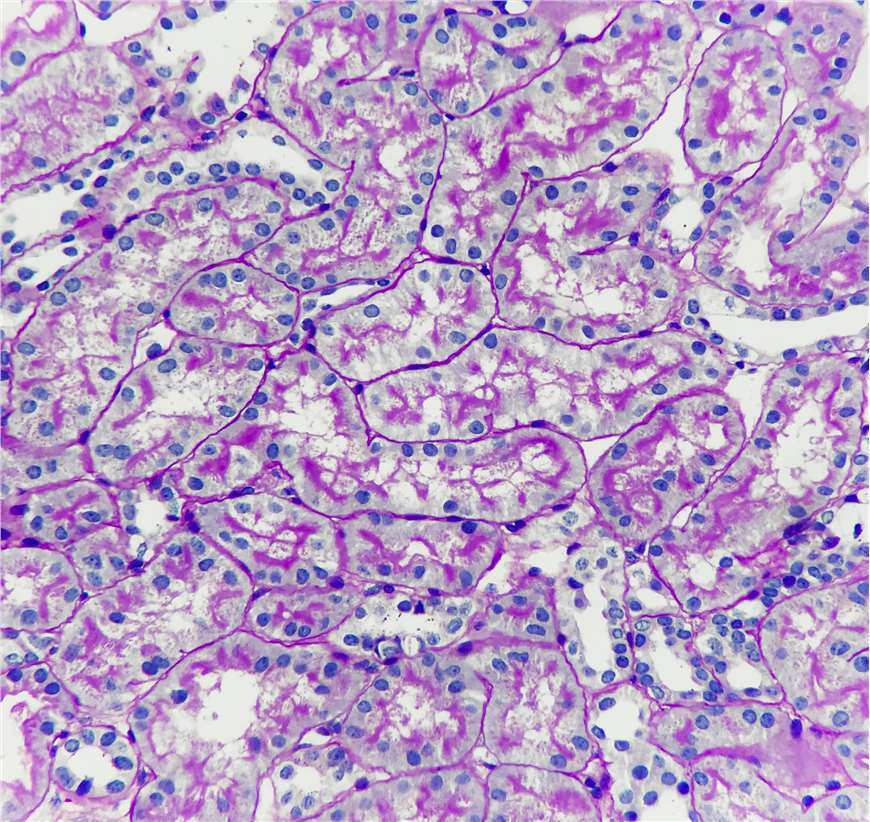Periodic Acid-Schiff (PAS) staining is a widely used technique in histopathology for the demonstration of carbohydrates and carbohydrate-rich compounds in tissues. It is an easy, reproducible stain that provides exceptional stain quality.
PAS staining demonstrates polysaccharides, mucin, glycogen, certain glycoproteins and glycolipids, basement membrane, and certain fungus. The glycogen, mucin, and fungi will be stained purple, and the nuclei will be stained blue.

The Principle of PAS Staining
The basis of PAS staining is to oxidize the tissues by periodic acid to increase the number of aldehyde groups present therein. Subsequently, the sample is treated with the Schiff reagent, which reacts with two contiguous aldehyde groups to produce a characteristic red-purple coloration.
PAS Staining Technique
Periodic acid oxidizes some of the carbohydrates in the tissue to aldehydes. The carbohydrates involved are 1-2 glycols. Since not all carbohydrates contain this structure, the PAS staining cannot be used for carbohydrates in general but only for those containing 1-2 glycols or closely related structures, such as one in which an amino group replaces one of the hydroxyl groups.
The PAS reaction is quite straightforward. Sections are first brought into water, and then 1% periodic acid solution is applied for 10 to 30 minutes. Wash the sections to remove any traces of the periodic acid, then Schiff's reagent is applied for a while, and again for 10 to 30 minutes. Rinse off the Schiff's reagent with water until the water is clear and the sections look pink. To a certain extent, the color will deepen somewhat as the washing continues.
The intensity of staining mainly depends on three factors:
1) The duration of oxidation and the amount of aldehyde produced
Increasing the oxidation time will generally increase the depth of staining. However, if the amount of target material is sparse, it may all be oxidized fairly quickly and further oxidation will have no effect on it.
2) The length of time in Schiff's reagent
Longer applications of Schiff's reagent also usually increase the depth of staining. Again, this can be overdone, and very intense staining may mask some of the lesser-dyed material.
3) The quality of Schiff's reagent
Only a water-clear or pale amber solution is acceptable. In any case, all new batches of Schiff's reagent should be tested against known tissues that you are familiar with to ensure that batch-to-batch staining is the same or very similar.
The Applications of PAS Staining
1) PAS helps to demonstrate glycogen, cellulose and starch. This is useful for detecting glycogen deposits in liver when glycogen storage disease is suspected. Glycogen granules may also be visible in tumors of the bladder, kidney, ovary, pancreas, and lung.
2) Basement membrane can also be visualized by PAS staining. The PAS is most commonly used to show the thickness of glomerular basement membrane when renal disease is being assessed.
3) Certain fungi in tissue samples can be demonstrated by PAS staining due to the high carbohydrate content of their cell wall/capsule.
4) Mucin, particularly acid mucin is demonstrated by PAS. It is important in endocervical, intestinal and bronchial glands.
5) PAS helps to demonstrate cerebrosides and gangliosides. It is helpful for the diagnosis of Gaucher's disease, Krabbe's disease and lysosomal storage diseases, etc.